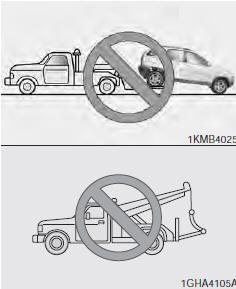Towing

If emergency towing is necessary, we recommend having it done by an authorized Kia dealer or a commercial tow-truck service. Proper lifting and towing procedures are necessary to prevent damage to the vehicle.
The use of wheel dollies or flatbed is recommended.
For trailer towing guidelines information, refer to section 5 “Driving Tips”.

On 4WD vehicles, your vehicle must be towed with a wheel lift and dollies or flatbed equipment with all the wheels off the ground.

On 2WD vehicles, it is acceptable to tow the vehicle with the rear wheels on the ground (without dollies) and the front wheels off the ground.
When being towed by a commercial tow truck and wheel dollies are not used, the front of the vehicle should always be lifted, not the rear.

NOTICE
• Do not tow the vehicle backwards
with the front wheels on the
ground as this may cause damage
to the vehicle.
• Do not tow with sling-type equipment.
Use wheel lift or flatbed equipment.
When towing your vehicle in an emergency without wheel dollies : 1. Set the ignition switch in the ACC position.
2. Place the transaxle shift lever in N (Neutral).
3. Release the parking brake.
NOTICE
Failure to place the transaxle shift
lever in N (Neutral) may cause internal
damage to the transaxle.


Towing with a vehicle other
than a tow truck
If towing is necessary, we recommend
you to have it done by an
Authorized Kia dealer or a commercial
tow truck service.
If towing service is not available in an emergency, your vehicle may be temporarily towed using a cable or chain secured to the emergency towing hook under the front or rear of the vehicle. Use extreme caution when towing the vehicle. A driver must be in the vehicle to steer it and operate the brakes.
Towing in this manner may be done only on hard-surfaced roads for a short distance and at low speeds.
Also, the wheels, axles, power train, steering and brakes must all be in good condition.
• Do not use the tow hooks to pull a vehicle out of mud, sand or other conditions from which the vehicle cannot be driven out under its own power.
• Avoid towing a vehicle heavier than the vehicle doing the towing.]
NOTICE
• Attach a towing strap to the tow
hook.
• Using a portion of the vehicle other than the tow hooks for towing may damage the body of your vehicle.
• Use only a cable or chain specifically intended for use in towing vehicles. Securely fasten the cable or chain to the towing hook provided.
• Before emergency towing, check that the hook is not broken or damaged.
• Fasten the towing cable or chain securely to the hook.
• Do not jerk the hook. Apply steady and even force.
• To avoid damaging the hook, do not pull from the side or at a vertical angle. Always pull straight ahead.
CAUTION
Use extreme caution when towing
the vehicle.
• Avoid sudden starts or erratic
driving maneuvers which
would place excessive stress
on the emergency towing
hook and towing cable or
chain. The hook and towing
cable or chain may break and
cause serious injury or damage.
• If the towing vehicle can hardly
move, do not forcibly continue
the towing. Contact an
Authorized Kia dealer or a
commercial tow truck service
for assistance.
• Tow the vehicle as straight ahead as possible.
• Keep away from the vehicle during towing.

• Use a towing strap less than 5 m (16 feet) long. Attach a white or red cloth (about 30 cm (12 inches) wide) in the middle of the strap for easy visibility.
• Drive carefully so that the towing strap is not loosened during towing.
When your vehicle is being
towed by another vehicle
other than a tow truck (in case
of an emergency)
• Turn the ignition switch to ACC so
the steering wheel isn’t locked.
• Place the transaxle shift lever in N (Neutral).
• Release the parking bake.
• Vehicles equipped with automatic transaxles should not exceed 45 km/h (28 mph) and should not be towed more than 80 km (50 miles).
• Vehicles equipped with manual transaxle should not be towed in excess of 88 km/h (55 mph) and should not be towed more than 645 km (400 miles).
• Press the brake pedal with more force than normal since you will have reduced brake performance.
• More steering effort will be required because the power steering system will be disabled.
• If you are driving down a long hill, the brakes may overheat and brake performance will be reduced. Stop often and let the brakes cool off.
NOTICE
To prevent internal damage to the
transaxle, never tow your vehicle
from the rear (backwards) with all
four tires in contact with the surface.
Tips for towing a stuck vehicle The following methods are effective when your vehicle is stuck in mud, sand or similar substances that prevent the vehicle from being driven out under its own power.
• Remove the soil and sand, etc.
from the front and the back of the tires.
• Place a stone or wood under the tires.
See also:
Economical operation
Your vehicle's fuel economy depends
mainly on your style of driving, where you
drive and when you drive.
Each of these factors affects how many
kilometers (miles) you can get from a liter
(gallon ...
A COMFORTABLE AND SOFT RIDE (TOO SOFT)
Behind the wheel of the new Optima it’s easy to point out several more faults
– although there are certainly some positive aspects to the driving experience
as well.
On the down-size, the ca ...
Before driving
WARNING - ENGINE EXHAUST CAN BE DANGEROUS!
Engine exhaust fumes can be extremely dangerous. If, at any time, you smell
exhaust fumes inside the vehicle, open the windows
immediately.
• Do not i ...


